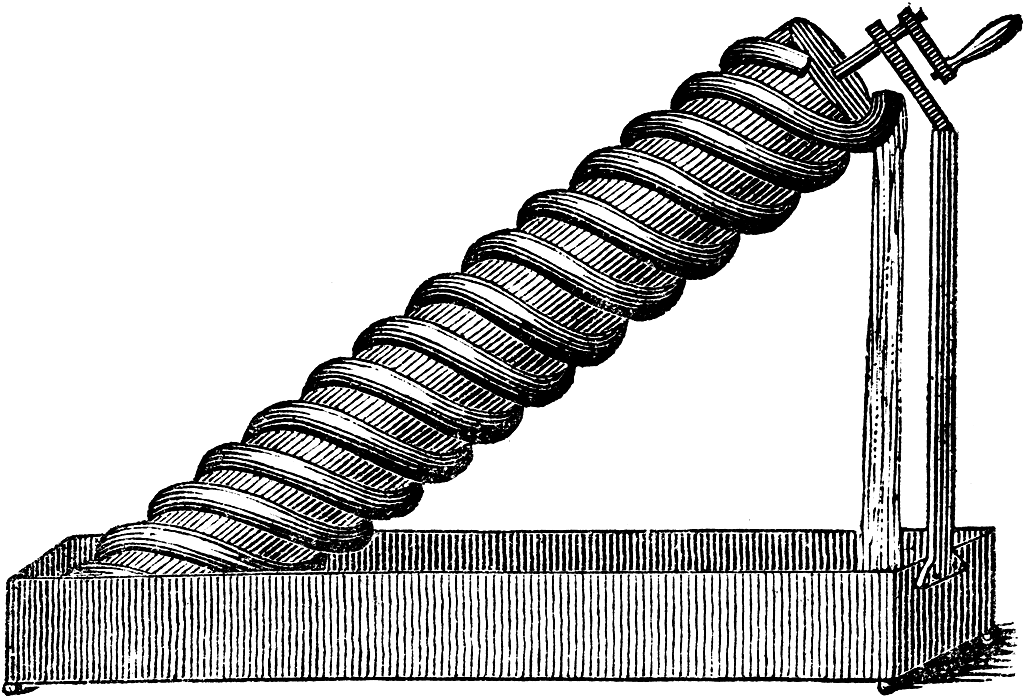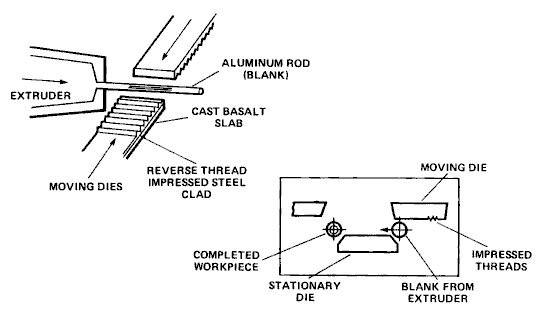Choosing the Correct Bolt Threading
For most people, the technical details about bolts extend to little more than their dimensions and the aisle they’re found in at Home Depot. But for those who use them in demanding applications like the oil and gas industry and construction, there is more to be considered. These folks are the connoisseurs of fasteners, who keep up with standards from ASTM and other publishers and ask which method for creating threads — cut threading and roll threading — results in the best product. The quick answer is that they can both produce quality threads, but it helps to understand their differences. First, a short history of bolt threads.
History of Bolt Threads
Many historians believe the first application of a spiraled shape formed on a material (i.e., a thread) was by Archytas of Tarentum, known as the inventor of mathematical mechanics, around 400 B.C. His spiral was used for raising up water in a column and pressing grapes (Figure 1).

Figure 1: Archytas’ water screw is recognized as the first use of a spiral, in this case for raising water.
The thread evolved slowly until the mid-1400s when a threaded device was demonstrated for use in fastening. Johannes Gutenberg and others later used hand-made threaded fasteners to hold objects together. Among dozens of other ideas, Leonardo da Vinci’s notebooks record the details of screw-cutting machines, and in 1568 Jacques Besson made the first one. The Industrial Revolution spurred the development of more sophisticated equipment that could mass-produce what we now consider screws and bolts. Produced by: Engineering 360 Media Solutions November 2017 Examining Bolt Threading Sponsored by: Bayou City Bolt & Supply Co., Inc. Sponsored by: Produced by: 2 Examining Bolt Threading For many years there were no standards of any kind for bolts in America, Europe or Asia. Their variety increased exponentially until the first half of the 20th century, when the United States, Canada, and England came up with thread standards based on Imperial measurements. This was followed in 1947 by standards from the newly formed International Organization for Standardization (ISO). Other standards dedicated to specific applications have been created and modified since then.
The Roll Threading Process.
There are a variety of ways to create the threads of a fastener, but the most common by far are the cutting and rolling methods. The primary difference between the two is that cut threading removes metal from a round bar stock to create the spiraled pattern while the rolling process displaces the metal on the bar from its original position but does not remove it. In the cutting process, the round metal bar is placed on a lathe and as it rotates a cutting die creates the threads. The roll threading process (Figure 2) is performed by pressing (extruding) hardened steel “rolling dies” into the rotating bar, reforming the surface into threads.

Figure 2: The roll threading process.
Generally speaking, a cut-threaded bolt has a body diameter equal to the thread diameter, and a rolled-thread bolt has a body diameter less than the threaded diameter. That is, the diameter of the body and thread sections of a cut-threaded bolt are the same, but a roll-threaded bolt’s threaded section may be larger than its body. Does one process decrease the strength of the fastener? The process by which the threads are produced can influence the final strength of a bolt. The threads of a rolled bolt may be stronger, including its root diameter. The weakest part of any fastener is the deepest region of its threads (the root), and although the thread diameters in each case are the same the cold formed root diameter of a rolled thread may increase in strength. So while many other factors also play a role in the strength of a bolt, we will see that the type of thread form can also be an issue.
Cut Threaded vs Roll Threaded Bolts
The threads on most bolts are created by roll threading, although cut-threaded bolts are also common and even required for some special applications. The primary advantage of using the cut-threading technique is that it can produce bolts adhering to any specification, and limitations on diameter and thread length are minimal. All specifications — standardized by ASTM and otherwise — can be met with cut threads.
From the manufacturer’s perspective, the roll threading process provides significant benefits as it is less labor-intensive and can produce bolts more quickly, saving time and money. As the process achieves threads by reforming the metal rather than removing it, there is less waste and metal cost along with less galvanizing, heat treating and plating materials.
The process has other advantages as well. The cold working (strengthening metal by changing its shape without heating it) that threads receive during the rolling process increases their tensile strength as well as shear and fatigue resistance. As a roll-threaded bolt’s body diameter may be smaller, it can weigh less than a cut-threaded bolt, which can somewhat reduce bulk shipping costs. Roll-threaded bolts are also smoother as the operation produces a more consistent surface.
In addition, the rolling process does not sever the fibers of the material as they are during cut threading, and there are no high spots that can cause torqueing or loosening in service. Cutting also leaves torn particles that can potentially cause assembly problems, while rolled threads are burnished so they are less prone to this problem.
How to Choose Your Bolt Thread Method
Practically speaking, either the thread-creation process can produce high-quality products. Although roll threading has inherent characteristics that result in better performance, the improvement may be negligible in many applications. The primary reason roll threading has become popular is because it requires less labor and materials and is better suited for mass production than cut threading, producing excellent results at less cost. From the user’s perspective, it’s generally more prudent to concentrate on application-specific requirements such as plating and other factors than how the bolts threads were created.
BAYOU CITY BOLT & SUPPLY CO., INC. 6331 Cullen PO Box 330264 Houston, TX, 77233-0264 Tel: (713) 747-3924
ENGINEERING 360 MEDIA SOLUTIONS 201 Fuller Road, Suite 202 Albany, NY 12203-3621 Tel: +1 518 880 0200
ABOUT BAYOU CITY BOLT & SUPPLY CO., INC.
